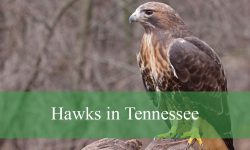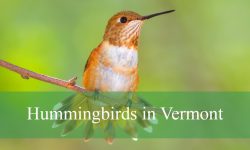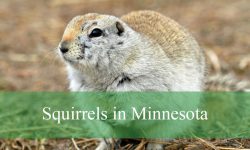Ohio is a fantastic place for birdwatchers, especially those interested in spotting finches. With its diverse landscapes—woodlands, fields, parks, and backyards—the state offers rich habitats that attract a wide variety of species. Finches in Ohio are commonly seen throughout the year, adding flashes of color and cheerful songs to the scenery.
These small, active birds are known for their vibrant plumage, distinct calls, and seed-cracking beaks. Some species are permanent residents, while others appear only in winter or during irruption years. The diversity of finches in Ohio provides endless opportunities for bird lovers to observe and enjoy these fascinating songbirds in both rural and urban settings.
This guide highlights 21 types of finches in Ohio, from the well-known American Goldfinch to extremely rare visitors like the Eurasian Siskin. Each entry includes identification tips, pictures, and details about their behavior, diet, and preferred habitats—perfect for anyone eager to learn more about Ohio’s finch population.
Different Types Finches Found in Ohio
American Goldfinch (Spinus tristis)
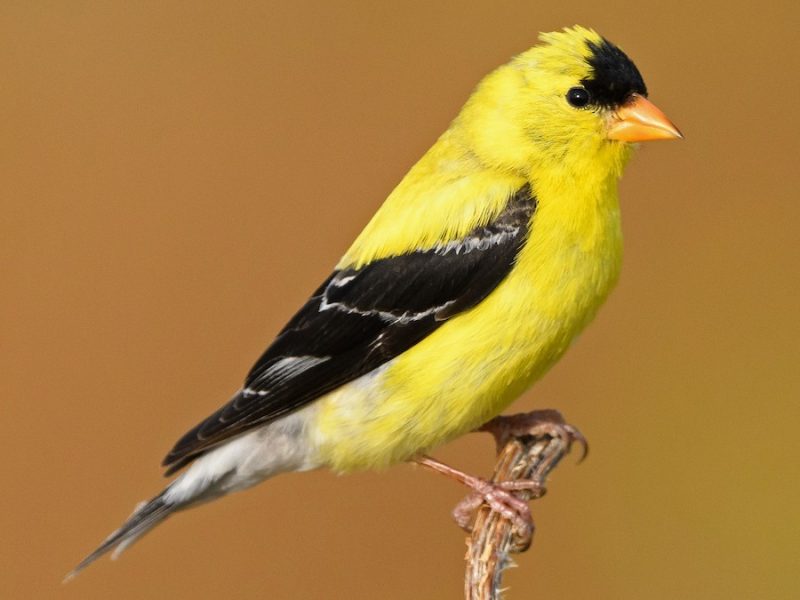
The American Goldfinch is a small, vibrant songbird known for its striking yellow plumage in males during the breeding season, contrasted by black wings with white markings and a black forehead. Females are more subdued in color, with olive-yellow tones. They measure around 4.3 to 5.1 inches in length with a wingspan of 7.5 to 8.7 inches. Their call is a sweet, high-pitched “per-chick-o-ree,” often given in flight, and their flight style is undulating, giving them a bouncing appearance in the air.
These finches are highly social and often form flocks, especially outside of the breeding season. They are late nesters, typically waiting until mid-to-late summer when thistle plants are abundant. Their primary diet consists of seeds, particularly from sunflowers, dandelions, and thistles, and they rarely eat insects. Goldfinches are commonly attracted to backyard feeders stocked with nyjer (thistle) or sunflower seeds.
In Ohio, the American Goldfinch is a widespread and very common resident, particularly noticeable during summer when males are at their brightest. They inhabit weedy fields, meadows, open woodlands, and suburban areas with scattered trees and seed-producing plants. Their cheerful songs and presence at feeders make them one of the most beloved backyard birds in the state.
House Finch (Haemorhous mexicanus)
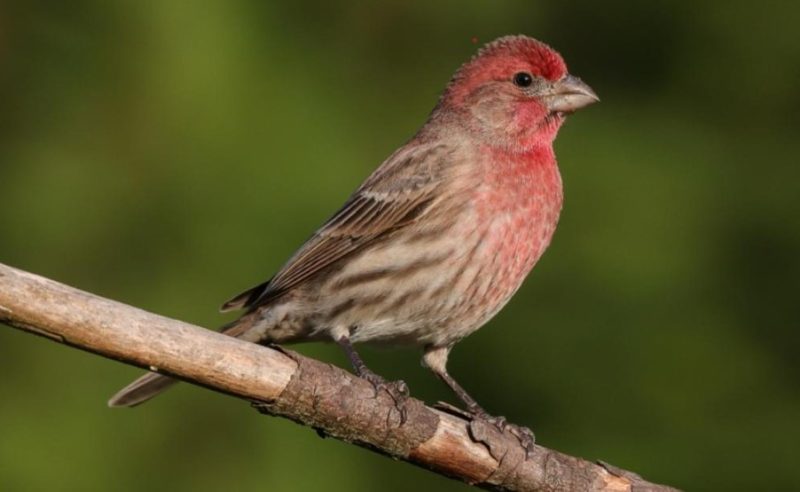
The House Finch is a small finch with a sturdy build and a short, conical beak. Males are easily identified by their reddish forehead, breast, and rump, though the intensity of red can vary depending on diet. Females and juveniles are streaky brown and lack the red coloring. These birds typically measure between 5 and 6 inches long, with a wingspan of about 8 to 10 inches. Their song is a long, jumbled warble, and they often sing from rooftops, trees, or wires.
These finches are well adapted to human environments and are frequently found in towns, suburbs, and cities. They nest in cavities, ledges, hanging planters, and even wreaths, often near human activity. House Finches feed mainly on seeds, grains, and fruit, and are common visitors to bird feeders stocked with sunflower or millet seeds.
In Ohio, House Finches are abundant year-round residents and are especially prevalent in suburban and urban areas. Originally native to the western U.S., they were introduced to the East in the 1940s and have since spread widely. They thrive in areas with ornamental plantings, feeders, and artificial structures, making them one of the most visible finches in the state.
Purple Finch (Haemorhous purpureus)
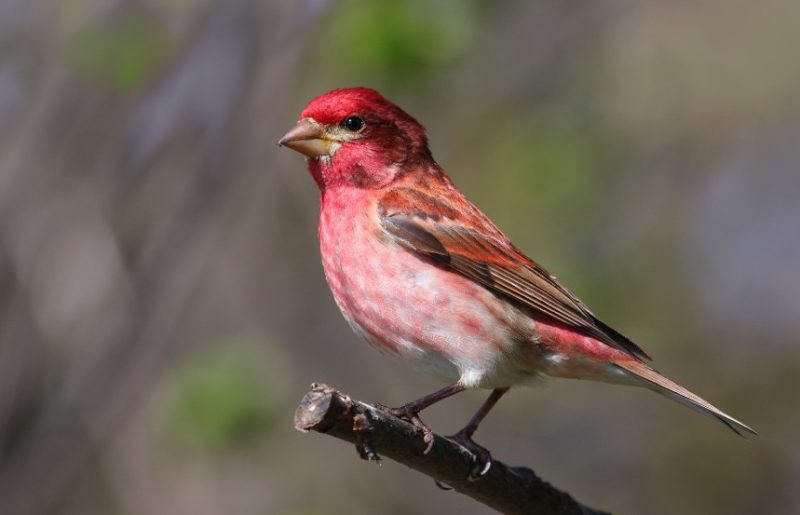
The Purple Finch is a medium-sized finch with a chunky body and a notched tail. Males display a rich raspberry-red coloration on the head, chest, and back, while females are heavily streaked with brown and feature a distinct white eye stripe. These birds measure about 6 inches in length with a wingspan of 9 to 10.2 inches. Their song is a melodious warble, more fluid and musical than the House Finch’s.
Purple Finches prefer coniferous and mixed forests during the breeding season, but in winter, they migrate to more southern areas, including Ohio. They are somewhat nomadic in winter, depending on food availability, and may visit feeders where black oil sunflower seeds are offered. Their diet includes seeds, berries, and buds, and they forage both on trees and on the ground.
In Ohio, Purple Finches are fairly common winter visitors, especially during years when their northern food supplies are scarce. They are most often seen in woodlands, parks, and residential areas with feeders. Their presence varies from year to year, and they can sometimes be confused with the more common House Finch, though careful observation of coloration and markings can distinguish them.
Pine Siskin (Spinus pinus)

The Pine Siskin is a small, streaky brown finch with subtle yellow patches on the wings and tail, which are more visible in flight. It has a sharply pointed bill and notched tail. This species measures around 4.3 to 5.5 inches long and has a wingspan of 7.1 to 8.7 inches. Their call is a distinctive buzzy “zreeeeee,” and they often chatter in flocks while feeding or flying.
These birds are known for their erratic migration patterns, appearing in large numbers in some winters and scarcely at all in others. They are highly sociable and often mix with goldfinch flocks. Pine Siskins primarily feed on seeds, especially from conifers, alders, and birches, but they also frequent feeders during the winter, preferring nyjer and sunflower seeds.
In Ohio, Pine Siskins are irregular winter visitors, more commonly seen during irruption years when food is scarce farther north. They are found in forests, wooded parks, and backyards with feeders, often in energetic, noisy flocks. Their unpredictable appearances make them an exciting find for birdwatchers in the state.
Evening Grosbeak (Coccothraustes vespertinus)

The Evening Grosbeak is a large, heavyset finch with a thick, conical bill. Males are striking with bright yellow bodies, black wings with white patches, and a bold yellow forehead. Females are more subdued with grayish tones, but still exhibit black and white wings. These birds are about 6.3 to 8.7 inches long with a wingspan of 11 to 14 inches. Their call is a sharp “cheer” or “cleer,” and their presence is often first noticed by their distinctive calls overhead.
These birds travel in noisy flocks and are primarily seed eaters, feeding on maple seeds, conifer seeds, and fruit. They are also known to eat insects during the breeding season. Evening Grosbeaks visit feeders during the winter when natural food is limited, favoring sunflower seeds and cracked corn. Their powerful bills allow them to crack open hard seeds with ease.
In Ohio, Evening Grosbeaks are uncommon winter visitors and tend to appear more frequently during irruption years, when food shortages drive them south. They are most likely to be seen in wooded areas, rural backyards, and near conifer groves. Their bold appearance and flocking behavior make them a memorable and sought-after winter sighting for bird enthusiasts.
Common Redpoll (Acanthis flammea)
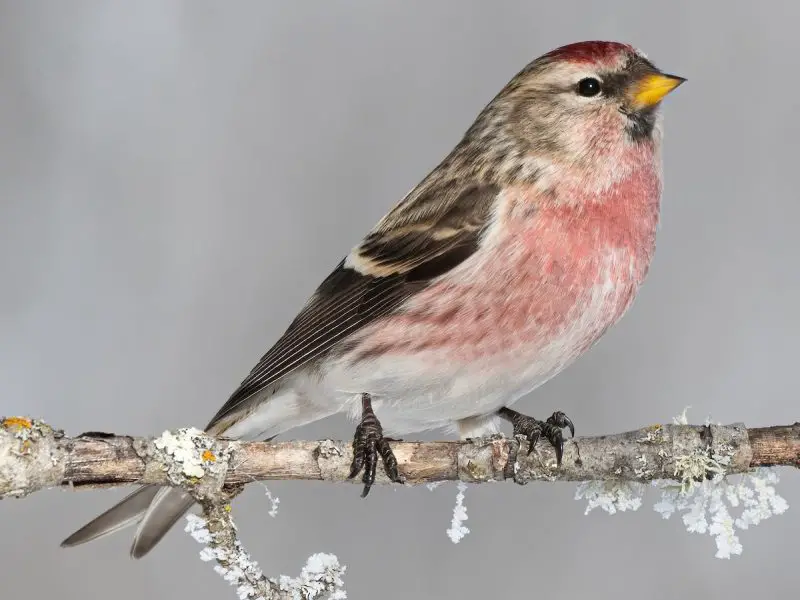
The Common Redpoll is a small, energetic finch with a round body and a sharply pointed yellow bill. It has a red cap on its forehead, black chin, and streaked brown and white plumage. Males often show a pinkish wash on the breast. These birds are about 4.7 to 5.5 inches in length with a wingspan of around 7.5 to 8.7 inches. Their calls are metallic “chit-chit” sounds, and they frequently chatter while in flocks.
This species is known for its irruptive winter behavior, appearing in large numbers in Ohio during certain years, depending on seed crop conditions farther north. They are social and tend to form large flocks, often mixed with Pine Siskins or American Goldfinches. Their acrobatic feeding behavior includes hanging upside down to extract seeds.
In Ohio, Common Redpolls are uncommon to rare, mostly seen during irruption years from November through March. They prefer open woodlands, weedy fields, and backyard feeders that offer nyjer or sunflower seeds. Observers should check mixed flocks closely, as Hoary Redpolls can sometimes be found among them.
Red Crossbill (Loxia curvirostra)

The Red Crossbill is a medium-sized finch distinguished by its unique crossed mandibles, specially adapted to pry seeds from conifer cones. Males are brick-red to orange-red with dark wings, while females are mostly olive-yellow. They measure about 5.5 to 6.5 inches long, with a wingspan of 10 to 11 inches. Their calls are sharp “kip-kip” notes, with distinct flight calls that can vary between types or “call types.”
Red Crossbills are highly nomadic and move erratically across North America in search of good cone crops. They often travel in small, noisy flocks and feed on spruce, pine, fir, and hemlock cones. They are agile feeders, using their unique bills to extract seeds while clinging to branches in all directions.
In Ohio, Red Crossbills are considered rare and irregular visitors, most likely during winters when cone crops fail in their northern breeding ranges. Sightings typically occur in conifer-rich habitats such as state parks, cemeteries, or forest preserves. Because of their nomadic nature and variability in appearance, spotting one is always a notable event for Ohio birders.
White-winged Crossbill (Loxia leucoptera)
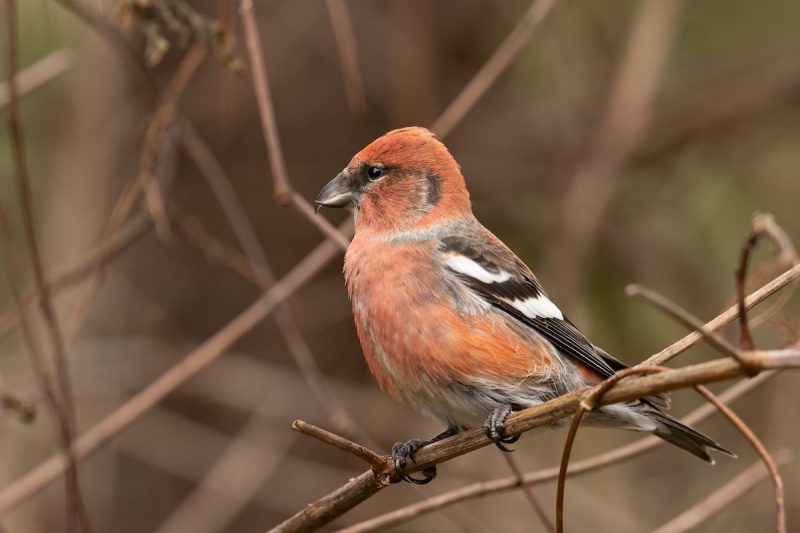
The White-winged Crossbill is a striking finch with crossed mandibles and bold white wing bars that make it easy to distinguish from its close relative, the Red Crossbill. Males are rosy pink with black wings and white wing bars, while females are yellowish with similar markings. They range in size from 5.9 to 6.7 inches long, with a wingspan of about 10 to 11 inches. Their song is a jumble of twitters and trills, and they often emit a high-pitched “kip” call.
These birds are specialized for feeding on conifer seeds, particularly from spruce and tamarack cones, and they often cling acrobatically to branches as they forage. They are nomadic and irruptive, meaning they move unpredictably based on food availability, sometimes traveling hundreds of miles outside their typical range.
In Ohio, the White-winged Crossbill is very rare and usually seen only during irruption years, mostly in the northern part of the state. They are typically found in mature conifer stands, arboretums, or well-wooded parks. Because they rarely visit feeders, spotting one requires some luck and often a trip to suitable habitat in the right year.
Pine Grosbeak (Pinicola enucleator)
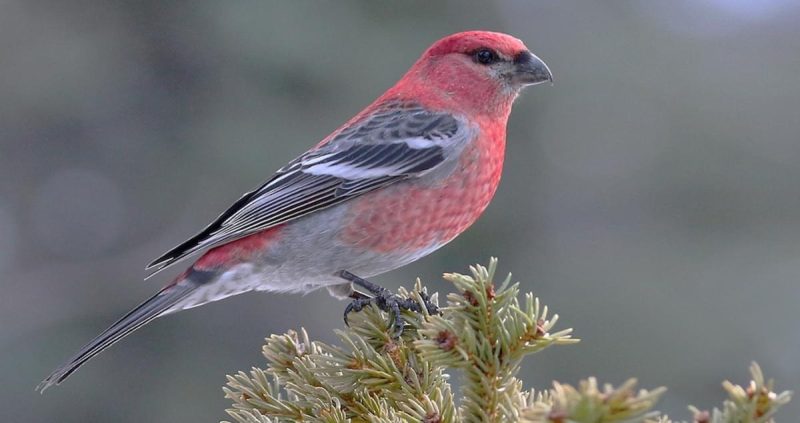
The Pine Grosbeak is a large, plump finch with a thick bill and a gentle demeanor. Males are rosy red with gray wings and tail, while females are yellowish-orange on the head and chest with gray bodies. These birds are about 8 to 10 inches long and have a wingspan of 12 to 14.5 inches. Their calls are soft, musical whistles, and their song is a slow, sweet warble.
Pine Grosbeaks primarily feed on buds, fruits, and seeds, favoring mountain ash berries and maple buds in winter. Unlike many other finches, they are not very active and often sit quietly while foraging in small groups. They are known for being tame and approachable, often allowing close views.
In Ohio, Pine Grosbeaks are rare winter visitors, typically appearing only during significant irruptions, mostly in the northern counties near Lake Erie. They prefer open woodlands, parklands, and areas with berry-producing shrubs. Because of their scarcity and calm behavior, encountering a Pine Grosbeak in Ohio is a prized moment for birdwatchers.
Hoary Redpoll (Acanthis hornemanni)
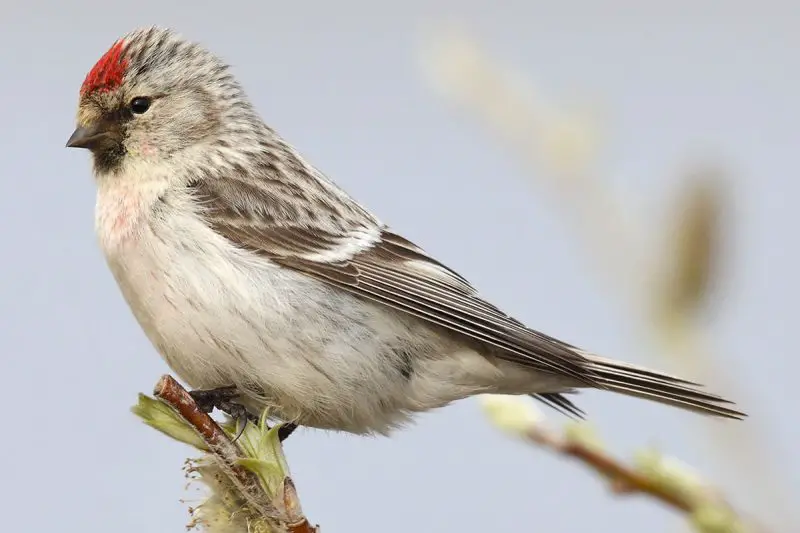
The Hoary Redpoll is a small finch closely related to the Common Redpoll but noticeably paler and fluffier in appearance. It has a frosty white body with faint streaks, a red forehead, and a small, stubby yellow bill. Males may show a slight pinkish tint on the breast. They measure around 4.7 to 5.5 inches long, similar to Common Redpolls, but appear lighter overall. Their calls are almost indistinguishable from those of Common Redpolls, consisting of buzzing and chipping notes.
This species is typically found in Arctic regions but occasionally ventures south during winter irruptions, often mingling with flocks of Common Redpolls. Hoary Redpolls feed on seeds from birch, alder, and weeds, and they may visit feeders offering nyjer or sunflower seeds. Identification often requires close observation or photographs to confirm the pale plumage and reduced streaking.
In Ohio, the Hoary Redpoll is extremely rare and usually spotted only during major redpoll irruption years. Most sightings come from northern Ohio, particularly near Lake Erie or in areas with open fields and abundant seed sources. Careful scanning of redpoll flocks during winter may reward the patient observer with a glimpse of this Arctic visitor.
Gray-crowned Rosy-Finch (Leucosticte tephrocotis)

The Gray-crowned Rosy-Finch is a stocky, medium-sized finch with a unique appearance. It features a gray head with a darker ear patch, chocolate-brown body, and pinkish tones on the wings and belly. Its size ranges from 5.5 to 8.3 inches long with a wingspan of about 13 inches. The finch’s song is a soft, warbling series of trills, and its call is a sharp “chew” note often heard as flocks fly.
This species is native to the high alpine and tundra regions of western North America and is rarely seen outside those habitats. Gray-crowned Rosy-Finches forage on seeds and insects and often feed on the ground, even in snow-covered areas. They are known for braving harsh environments and nesting on cliffs and rocky outcrops.
In Ohio, this finch is an extremely rare vagrant, with only a handful of records documented, usually during winter months. Sightings are typically associated with extreme weather patterns that may push these birds far from their mountainous homes. When they do appear, they are usually found near feeders or open habitats with seed-rich ground.
Brambling (Fringilla montifringilla)
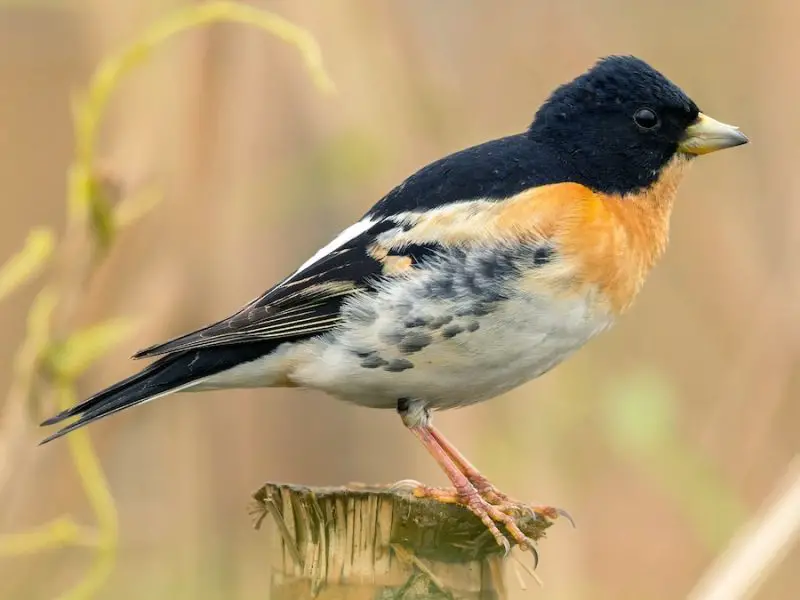
The Brambling is a colorful Eurasian finch that is only rarely spotted in North America. It has a striking orange breast, white belly, and a black head in breeding plumage, though winter birds are duller. Measuring around 5.5 to 6.3 inches in length with a wingspan of about 10 to 11 inches, its size and build resemble the closely related Chaffinch. Its calls include a harsh “krrr” and a cheerful warbling song.
Native to Europe and northern Asia, the Brambling typically migrates south within Eurasia, though a few stray across the Atlantic each year. They feed on seeds and insects and are often seen in mixed flocks with finches like chaffinches or sparrows in their native range.
In Ohio, Bramblings are accidental visitors, with very rare records from bird feeders during winter. Most sightings are linked to severe weather or disoriented migration paths. Because they resemble familiar native finches, close attention is needed to confirm their identity when one appears in the state.
Lesser Goldfinch (Spinus psaltria)
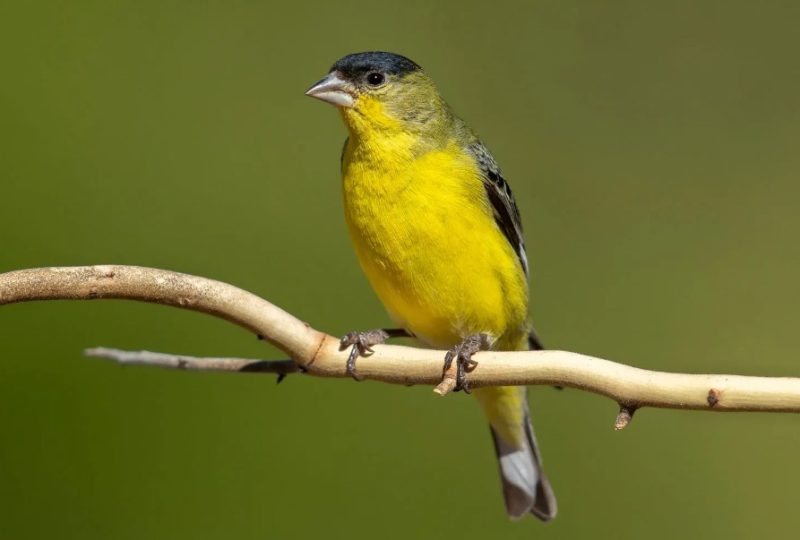
The Lesser Goldfinch is a small, vibrant finch with a bright yellow underside and either a black or greenish back depending on the population. It is roughly 4.3 to 4.7 inches long with a wingspan of 7.5 inches. Its cheerful song is a fast jumble of trills, warbles, and mimicry, similar to the American Goldfinch but with more complexity.
This species is common in the southwestern United States and Mexico, where it frequents open woodlands, gardens, and feeders. It feeds on seeds, especially sunflower and thistle, and is highly social, often gathering in flocks. Its range is expanding eastward in some areas, but it remains largely absent from the Midwest.
In Ohio, the Lesser Goldfinch is considered an extremely rare vagrant, with only a few confirmed sightings. Occurrences are usually in winter and are likely due to disoriented individuals. Birders spotting this species should document carefully, as its presence is notable for the region.
Lawrence’s Goldfinch (Spinus lawrencei)

Lawrence’s Goldfinch is a small and subtly beautiful finch found mostly in California and northern Mexico. Males have a gray body with yellow on the breast and wings, and a black face; females are more muted with no black mask. They are about 4.75 to 5 inches in length and have a soft, sweet warbling call.
Unlike many finches, Lawrence’s Goldfinches are erratic in their movements and may not return to the same breeding sites yearly. They feed on seeds of native plants like fiddlenecks and tarweeds and prefer open woodlands and brushy habitats. Their gentle, quiet behavior makes them less conspicuous than their bolder relatives.
In Ohio, Lawrence’s Goldfinch is an accidental visitor with very few records. Any appearance in the state is of high interest to ornithologists and birders, often prompting significant attention. These rare sightings usually occur at feeders or during unusual weather-driven dispersals.
European Greenfinch (Chloris chloris)
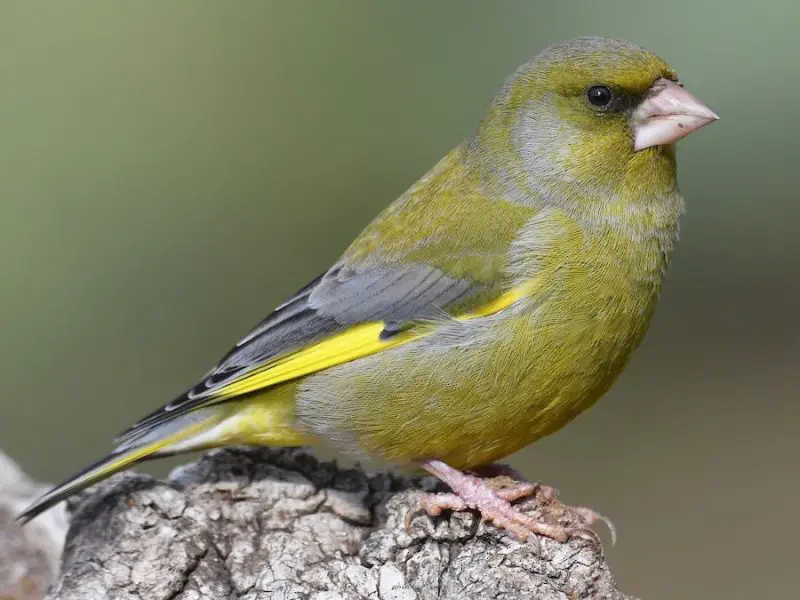
The European Greenfinch is a chunky, bright green finch with yellow edges on its wings and tail. Males are more vividly colored than females, which are duller and more brownish. This species is about 5.5 to 6 inches long with a wingspan of approximately 10 inches. Its song is a series of nasal trills and wheezy notes, often given in flight or from a perch.
Native to Europe and parts of western Asia, the European Greenfinch is a common garden bird overseas. It primarily feeds on seeds and buds, favoring sunflower seeds and grains. In its native range, it is often seen at feeders, hedgerows, and urban parks.
In Ohio, the European Greenfinch is not a naturally occurring bird but is known to escape from captivity. These rare escapees are sometimes spotted in urban or suburban areas but are not considered part of the established avifauna. They are often temporary sightings and do not persist or breed in the wild in the region.
Eurasian Siskin (Spinus spinus)
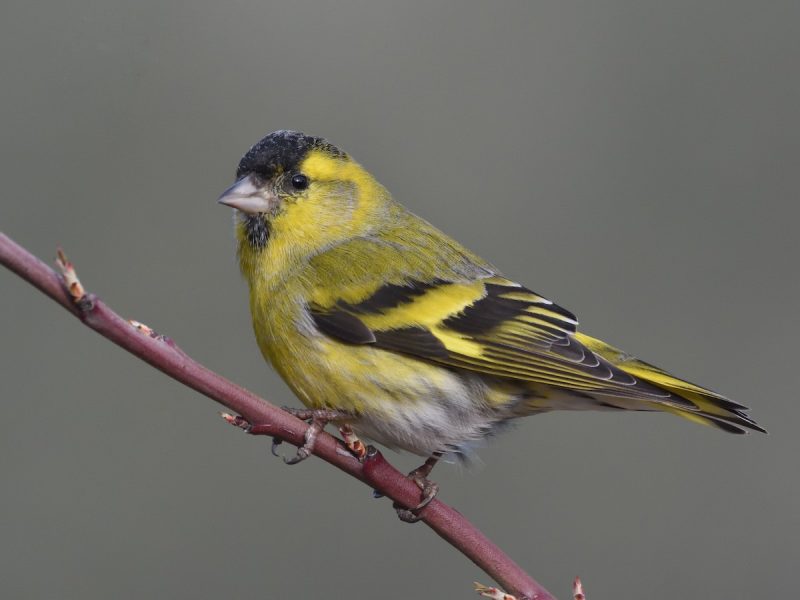
The Eurasian Siskin is a small, energetic finch with a sharp, pointed bill and lively appearance. Males display striking greenish-yellow plumage with black caps and black on the wings and tail, while females are more subdued with streaky olive and gray tones. Measuring about 4.5 to 5 inches in length, the siskin is known for its fast, warbling song and high-pitched calls often given in flight.
Native to Europe and parts of Asia, this species inhabits coniferous and mixed woodlands, as well as gardens during the non-breeding season. It feeds on alder, birch, and conifer seeds, often foraging in flocks. The Eurasian Siskin is agile and acrobatic, frequently hanging upside down from twigs as it feeds.
In Ohio, the Eurasian Siskin is considered a very rare vagrant, with only a few unconfirmed or debated records. If seen, it may appear at backyard feeders among American goldfinches or Pine Siskins. Any confirmed sighting would attract significant attention from birdwatchers and ornithological communities.
Thick-billed Longspur (Rhynchophanes mccownii)

The Thick-billed Longspur, once considered a finch-like sparrow, is a medium-sized bird with a stout bill and cryptic coloration. Males in breeding plumage have a bold black-and-white face pattern with chestnut shoulders, while females and winter birds are buffy and streaked. It ranges from 5.5 to 6.3 inches long and is better known for its dry, tinkling song performed in flight.
This species is native to the Great Plains and shortgrass prairies of the western U.S., where it nests on the ground and feeds on seeds and insects. It has experienced severe population declines due to habitat loss. During migration and winter, it moves into open fields and bare ground, though sightings are rare east of the Mississippi River.
In Ohio, the Thick-billed Longspur is a very rare and irregular visitor, usually reported only a handful of times. These occurrences are often tied to unexpected weather or disoriented migration. Because of its resemblance to sparrows and its rarity, it is often overlooked unless carefully observed.
Rosy-faced Lovebird (Agapornis roseicollis)

The Rosy-faced Lovebird is a small, stocky parrot with a colorful and endearing appearance. It has a bright green body, pinkish-red face and throat, and blue rump. Averaging about 6 inches in length, it emits high-pitched chirps and squeaks rather than melodic songs typical of finches.
Native to arid regions of southwestern Africa, this bird is not naturally found in North America but has established feral populations in cities like Phoenix, Arizona. It feeds on seeds, fruits, and vegetation, and is highly social, often seen in noisy flocks. Due to its popularity in the pet trade, escapees are occasionally seen far from its usual range.
In Ohio, the Rosy-faced Lovebird is not a wild species but sometimes appears as an escaped pet. These sightings typically occur in urban neighborhoods or near feeders but are fleeting, as the birds usually do not survive long in colder climates. They are not considered part of Ohio’s established birdlife.
Yellow-fronted Canary (Serinus mozambicus)

The Yellow-fronted Canary is a bright, eye-catching songbird with a yellow face and underparts, olive-gray back, and faint streaks on its flanks. Males sing a rich, warbling song, which is one of the reasons the species is commonly kept as a cage bird. It measures around 4.7 to 5 inches in length and resembles other true finches in shape and behavior.
This species is native to sub-Saharan Africa and is typically found in savannas, open woodlands, and cultivated areas. It feeds on seeds, grains, and small insects. Because of its adaptability and popularity in aviculture, it has been introduced to areas outside its native range, including islands and urban settings.
In Ohio, the Yellow-fronted Canary is occasionally reported as a non-native escapee. While not capable of establishing populations in the Midwest climate, individuals may briefly survive in the wild after escaping captivity. These sightings are rare and typically occur in summer or early fall before cold weather sets in.
Zebra Finch (Taeniopygia guttata)

The Zebra Finch is a small and active finch with distinctive plumage. Males are easily recognized by their orange cheeks, black and white bars on the throat and chest, and bright beaks, while females lack the bold cheek patches and have subtler coloring. These finches are about 4 inches in length and produce a repetitive, beeping song used in mating displays.
Native to Australia, Zebra Finches are highly social birds that inhabit dry grasslands and scrubby environments. They feed
In Ohio, the Zebra Finch is occasionally spotted in the wild due to escaped pets. They are not capable of surviving the winter, so such sightings are brief and limited to warmer months. Though not part of Ohio’s natural avifauna, they may turn up near feeders or in suburban parks following recent escapes.


